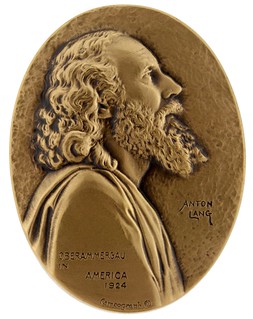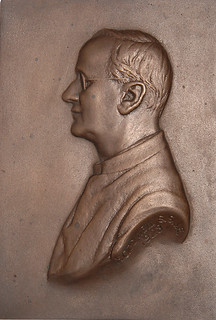
PREV ARTICLE
NEXT ARTICLE
FULL ISSUE
VOCABULARY TERM: CAMEOGRAPHDick Johnson submitted this entry from his Encyclopedia of Coin and Medal Terminology. Thanks. -Editor
  The lower right name on the oval medal (left) one might think would be the signature of the artist. It is not, it is the name of the actor shown on the medal in the role of Christ in the German passion play Oberammergan mentioned below. It is the only known medal made be the cameograph process in America. The New York studio had the 2-inch uniface medal struck by Medallic Art Company. The 4 5/8-inch medal on the right is one of several made in London for their studio established by the developer of the mechanical-photographic device. The Cameograph process was short lived because it could not equal that of live medallic artists. Cameograph. Projecting an object with a grid or beams of light to reproduce it; often of a face to model a portrait in relief. The use of a Cameograph was thought by its developers to aid in making a portrait more lifelike. However, at its best it makes the subject appear more stiff or frozen, in effect accomplishing just the opposite. It falls short in perspective and animation by limiting the artist's ability to interpret and vivify his subject. The technique is called physiognotrace ("tracing the face"). The Cameograph was a photographic and mechanical refinement developed in 1921 by an Englishman, Henry M. Edmunds, and patented in 1921 and 1923. It was based on a 16th century device, the drawing frame, which employed a rectangular frame with wires creating a grid through which the artist viewed the subject. The Cameograph's feature was to photograph the subject illuminated by numerous vertical beams of light. Two photographs were taken, on each side of the subject (to be able to view any hidden line in a shadow to create the bas-relief image). The photographs could be enlarged to any size. The operator traced the lines on the photos through a viewing microscope, controlling the milling of the cutter tool on the machine. It produced a relief of desired size in a media that could be easily cut (as plaster or wood). Today the use of the Cameograph would be considered unskillful (and perhaps amateurish). A medallist would prefer several photographic views from different angles instead, then interpret the subject or image. Sporadic use of the Cameograph occurred with the establishment in London and New York of Cameograph studios for bas-relief and medallic productions. One of their creations in New York was a portrait of actor Anton Lang who portrayed Christ in the German passion play Oberammergau on a medal of 1924. The Cameograph did not succeed beyond these early productions. CLASS 03.4 References:  Wayne Homren, Editor The Numismatic Bibliomania Society is a non-profit organization promoting numismatic literature. See our web site at coinbooks.org. To submit items for publication in The E-Sylum, write to the Editor at this address: whomren@gmail.com To subscribe go to: https://my.binhost.com/lists/listinfo/esylum All Rights Reserved. NBS Home Page Contact the NBS webmaster 
|